CS61A¶
约 1935 个字 553 行代码 18 张图片 预计阅读时间 17 分钟
概述
这个文档记录了之前学习CS61A的一部分笔记,当时并没有听完所有课,这份笔记不算特别完善。(当然有一部分是觉得没什么记的必要)
不得不说,这个课作为我上过的第一门国外网课,它的课程网站、作业OJ、包括指导教程都令我印象挺深的。
资源
FALL 2020
ANSEWR
GitHub - HobbitQia/CS61A-Fall-2020: My solutions for CS61A Fall 2020.
Python Tutor
Online Python Tutor - Composing Programs - Python 3
TextBook
Chapter 1: Building Abstractions with Function¶
基本特征¶
Features¶
- turediv / 浮点数
- floordiv // 整除
- 可以有多个返回值
def divide_exact(n,d) return n//d, n%d
字符串¶
- py 没有单独的字符类型,一个字符就是长度为 1 的字符串
- Python 中的字符串不能改变
- 反斜杠可以用来转义,使用 r 可以让反斜杠不发生转义。 如 r"this is a line with \n" 则 \n 会显示,并不是换行。(raw string)
- 字符串的截取的语法格式如下:变量[头下标:尾下标:步长]
str = '123456789'
print(str[0:-1])# 输出第一个到倒数第二个的所有字符
>>> 12345678
print(str[0])# 输出字符串第一个字符
>>> 1
print(str[2:5])# 输出从第三个开始到第六个的字符(不包含)print(str[2:])# 输出从第三个开始后的所有字符
>>> 345
print(str[1:5:2])# 输出从第二个开始到第五个且每隔一个的字符(步长为2)
>>> 24
- 字符串可以用 + 运算符连接在一起,用 * 运算符重复
print(ptr * 2)
交互¶
- Print 和 return
print输出的是 ‘’引号内的
return 所有
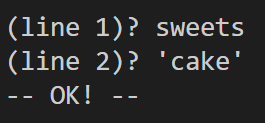

environment¶
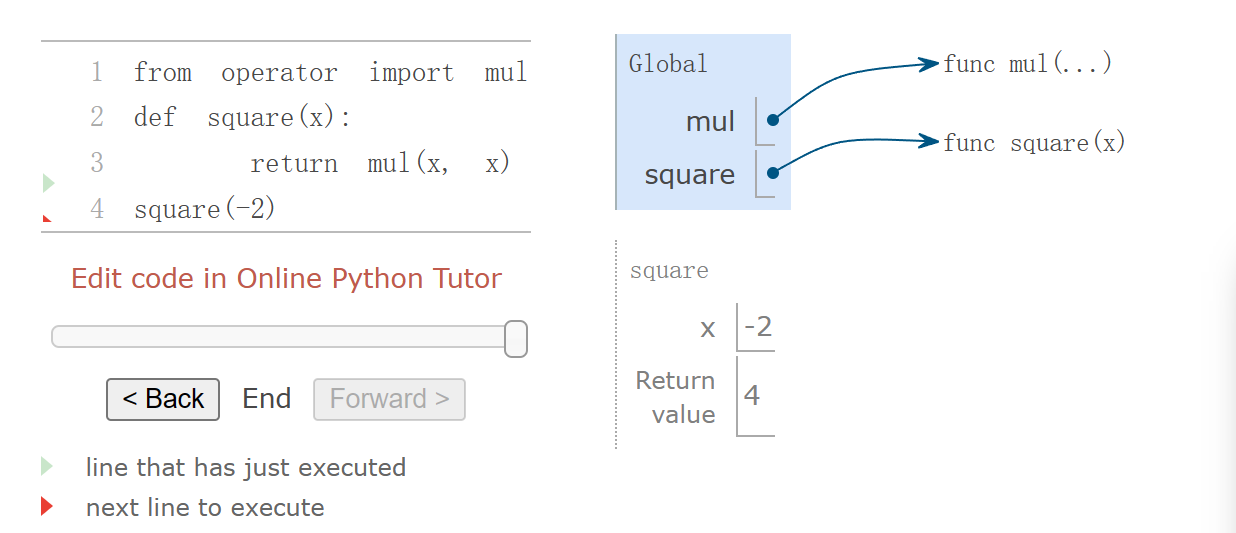 ¶
¶
- environment is combined with many frames.
- global frame and others(local frame)
- And at one time, there`s only one frame( the program can`t be in two distinct frames )
- 定义并不会创建frame 只有当运行到函数时才会创建
高阶函数的 Environment¶
Nested / Higher¶
# 一个嵌套函数
# make_adder(5) 将返回一个函数(+5的adder)
def compose(f,g):
def h(x):
return f(g(x))
return h
def make_adder(x):
def adder(y):
return y + x
return adder
>>> compose(f,make_adder(5))(4) ```完成调用
def print_sums(n):
"""Print all sums of arguments of repeated calls.
n 为总和 k 为下一个加和数字
>>> f = print_sums(1)(2)(3)(4)(5)
1
3
6
10
15
"""
print(n)
def next_sum(k):
return print_sums(n+k)
return next_sum
如何绘制¶


funciton¶
- from operator import add,mul //引入函数(build-in)
- docstring `````` ( HELP ) comments # 注释
 Print and None
Print and None
- Print 返回值为None None在py 中不是一个数值表达 ==> NoneType 和 int 不能进行计算(type Error)
Control
bool :
 对于 and 和 or 他们总是返回最后一个evaluate的对象,如果判断对象不是booleans,将返回数字;Ture and 13 will return 13 but not True
对于 and 和 or 他们总是返回最后一个evaluate的对象,如果判断对象不是booleans,将返回数字;Ture and 13 will return 13 but not True
iteration 迭代:

Test :
Assertions在False时 输出后面的字符串 ‘ ’或者“ ”

Doctest
- 全局
from doctest import testmod
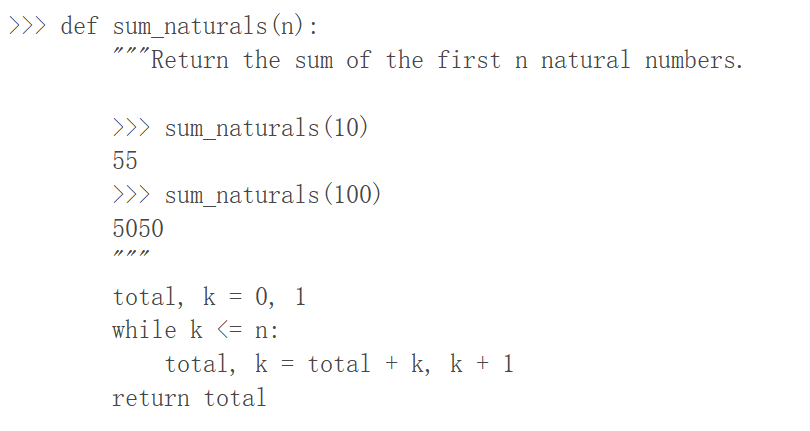
- 单个函数
from doctest import run_docstring_examples
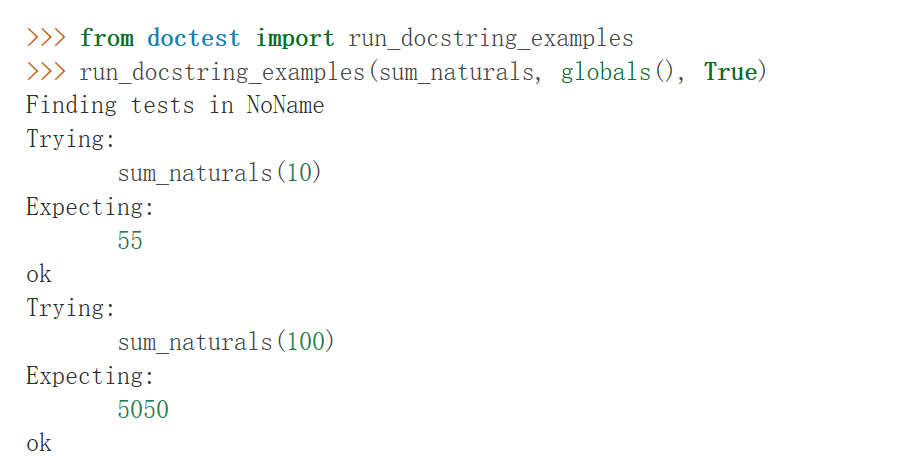
- 文件
python3 -m doctest
高阶函数
- Currying 只含有一个 参数
例如,g (x) (y) 等效于 f (x , y) , 这个转换的过程就被称为currying

from operator import add, mul
def curry2(f):
def g(x):
def h(y):
return f(x, y)
return h
return g
m = curry2(add)
add_three = m(3)
add_three(4)
m(2)(1)
- Lambda Expressions
定义此类函数时没有 intrinsic name
b = lambda x: lambda: x # Lambdas can return other lambdas!
c = b(88)
>>> c
Function
>>> c()
88
- Decorators 修饰符
用于更好地使用高阶函数
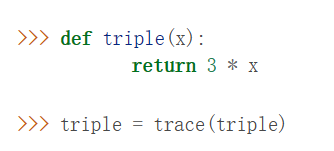 triple 绑定的是 trace 在调用triple之后绑定的返回值
triple 绑定的是 trace 在调用triple之后绑定的返回值
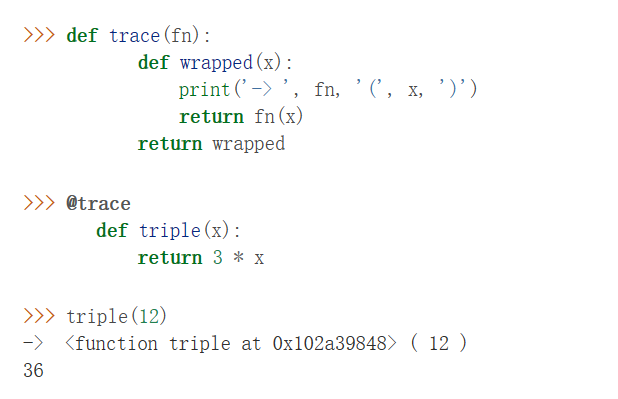 :::
:::
def print_sum(n):
//打印n个数的总和
print(n)
def f(k):
return print_sum(n+k)
return f
>>> print_sum(3)(5)(7)
n k print_sum(3) f(5)
3 5 print_sum(8) f(7)
8 7 print_sum(15) f
含有任意参数的函数¶
def average(*args):
k,sum = 0,0
while k < trials_count:
sum += original_function(*args)
k += 1
return sum / trials_count
return average
修饰¶
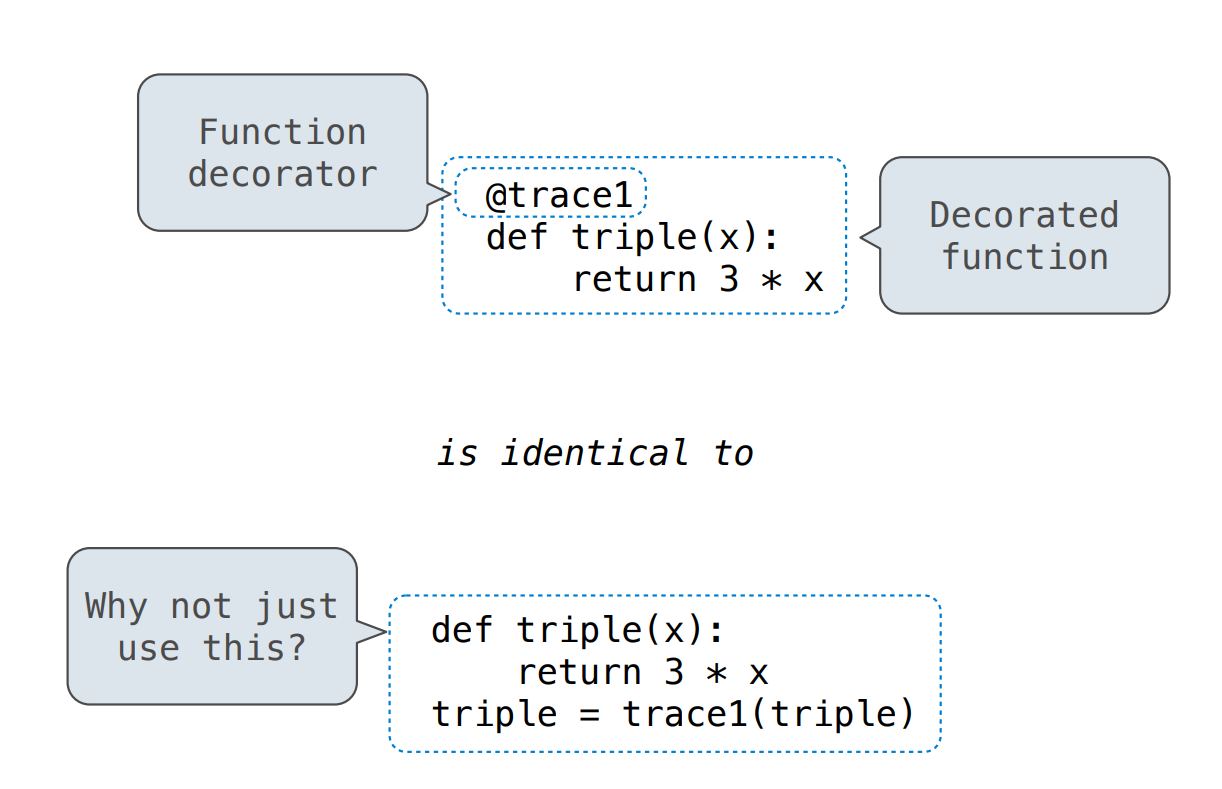
Recursive Function¶
基本构成¶
- basic case
- recursive case
例如,$f_{n+1} = f_n + f (n-1)$
- 借助 helper 函数 操纵更多参数
** Lambda表示¶
基础使用¶
Y算子/不动点¶
Chapter 2 : Bulilding Abstractions with Data¶
· Sequences¶
Lists¶
# 基本运算
>>> digits = [1, 8, 2, 8]
>>> len(digits)
4
>>> digits[3]
8
>>> [2, 7] + digits * 2 // mul 和 add 对 list
[2, 7, 1, 8, 2, 8, 1, 8, 2, 8]
>>> pairs = [10, 20], [30, 40](10, 20], [30, 40.md){#9e0fbd15a3b78d4010362d10a44e1fa2} // 包含list的list
>>> pairs[1]
[30, 40]
>>> pairs[1][0]
30
# unpack pair = [10,20]
1. pair[0]
2. x,y = pair
3. >>> from operator import getitem
>>> getitem(pair, 0)
10
Sequence Iteration¶
for <name> in <expression>:
<suite>
unpacking iteration
# 将list中的多个值赋给变量
>>> pairs = [1, 2], [2, 2], [2, 3], [4, 4](1, 2], [2, 2], [2, 3], [4, 4.md){#1e41902c4c4bd8a100fe6a2f77932c1c} // list含有相同数目元素
>>> for x, y in pairs:
if x == y:
same_count = same_count + 1
>>> same_count
2
range
>>> range(5,8) //包括 5 excluding 8
>>> list(range(3)) // range()
[0,1,2]
>>> for _ in range(3): // _ 表示不再suit中使用的变量 自动从 0 开始
print('Go Bears!')
Sequence Processing¶
[<map expression> for <name> in <sequence expression> if <filter expression>]
# 注意是在【】中进行,生成新的 List
>>> odds = [1, 3, 5, 7, 9]
>>> [x+1 for x in odds if ...]
[2, 4, 6, 8, 10]
# Aggregation
sum max min , etc
# reduce 重复计算
from functools import reduce
reduce(fn_reduce,iterable,initial)
# map
r = map(fn_map,iterable)
list(r)
#
>>> apply_to_all = lambda map_fn, s: list(map(map_fn, s))
>>> keep_if = lambda filter_fn, s: list(filter(filter_fn, s))
lists = [0,1,2,3,4,5,6,7]
# Membership
x in lists / not in
# Slicing
list[0:]
# Processing
1. sum(iterative[,start])
2. max(iterative[,key = function])
3. all(iterative) -> bool()
Trees¶
- Trees. 有一个 rootlabel 和 branches 它本身是一种用递归定义的数据结构
- 形式:[label , branches = [] ] [1,[ [2 , [3]] , [4,[5]] , [6,[7]] ]]
尤其注意branches的格式问题 也可以使用字典形式表示tree这种数据结构
- 对 tree 的遍历经常用到
for b in branches(t):
若已知为二叉树,也可以不断分为 left right 两个节点
h = **[**helper(branch,height + 1) for branch in branches(tree)**]**这样的语句会导致之后所有的返回值形成很深层次的嵌套**[2], 1, [[[[5]]]](2], 1, [[[[5]]].md)**最好在每一层级都“解压”**max(t)**这样之后返回的才是数值
Data abstraction of trees¶
- 此处的组件并不通过递归形成一个tree,只是单纯tree的component
- 注意 branches 的写法
## the first level for abstraction
# constructor
>>> def tree(root_label, branches=[]):
for branch in branches:
assert is_tree(branch), 'branches must be trees'
return [root_label] + list(branches)
# selector
>>> def label(tree):
return tree[0]
>>> def branches(tree):
return tree[1:]
## the second
>>> def is_tree(tree):
if type(tree) != list or len(tree) < 1:
return False
for branch in branches(tree):
if not is_tree(branch):
return False
return True
>>> def is_leaf(tree):
return not branches(tree)
- partition的tree做法
def partition_tree(n, m):
"""Return a partition tree of n using parts of up to m."""
if n == 0:
return tree(True)
elif n < 0 or m == 0:
return tree(False)
else:
left = partition_tree(n-m, m)
right = partition_tree(n, m-1)
return tree(m, [left, right])
# recursion tree in prefix order
def print_parts(tree, partition=[]):
if is_leaf(tree):
if label(tree):
print(' + '.join(partition))
else:
left, right = branches(tree)
m = str(label(tree))
print_parts(left, partition + [m])
print_parts(right, partition)
Excises and Application¶
- Add Tree
- 考虑递归的
Basic case和Recursive case - Hard : 确认对应位置
- Tip : using the
zipfunction
- Tip : using the
zip(iterable1,iterable2,...):
Returns a zip object, which is an iterator of tuples
如果参数长度不一,取最短的
>>> t2
[1, [5, [6]], [9], [4, [8], [1]]], [99](1]]], [99.md){#618df381853bde2dd02159e20c7c676c}
>>> t1
[1, [5, [6]], [8], [9]]
>>> list(zip(t1,t2))
[(1, 1), ([5, [6]], [5, [6]]), ([8], [9]), ([9], [4, [8], [1]](1].md))]
- 形成新的Tree
- 仍然是对 rucursive 结构考虑不是很清楚.
tree : [1, [5], [6, [7]]],branches中,每一个元素都代表一整个分支
def add_tree(t1,t2):
'''Return the addition tree of the two trees t1 and t2.
Adding up the corresponding value, and making a tree.
IF one branch is onlt in one tree, then it will be in the new tree
>>> numbers = tree(1,
... [tree(2,
... [tree(3),
... tree(4)]),
... tree(5,
... [tree(6,
... [tree(7)]),
... tree(8)])])
>>> print_tree(add_trees(numbers, numbers))
2
4
6
8
10
12
14
16
>>> print_tree(add_trees(tree(2), tree(3, [tree(4), tree(5)])))
5
4
5
>>> print_tree(add_trees(tree(2, [tree(3)]), tree(2, [tree(3), tree(4)])))
4
6
4
>>> print_tree(add_trees(tree(2, [tree(3, [tree(4), tree(5)])]), \
tree(2, [tree(3, [tree(4)]), tree(5)])))
4
6
8
5
5
'''
if is_leaf(t1) and is_leaf(t2):
return tree(label(t1) + label(t2))
elif is_leaf(t1):
return tree(label(t1) + label(t2), branches(t2))
elif is_leaf(t2):
return tree(label(t1) + label(t2), branches(t1))
else:
new_label = label(t1) + label(t2)
new_branches = [add_trees(b1, b2) for b1, b2 in zip(branches(t1), branches(t2))]
if len(branches(t1)) > len(branches(t2)):
new_branches += branches(t1)[len(branches(t2)):]
elif len(branches(t1)) < len(branches(t2)):
new_branches += branches(t2)[len(branches(t1)):]
return tree(new_label, new_branches)
-
Linked Lists¶
- 定义:与 tree类似,[ element , new_linked]
[ 2, [3, [4, 'empty']]]
-
four = [1,[2,[3,[4,'empty']]]]
# constructor
empty = 'empty'
def link(label , rest):
if is_link(rest):
return [label,rest]
def first(s):
assert is_link(s), "first only applies to linked lists."
assert s != empty, "empty linked list has no first element."
return s[0]
def rest(s):
assert is_link(s), "first only applies to linked lists."
assert s != empty, "empty linked list has no rest."
return s[1]
# convenience
def is_link(s):
return s == empty or (len(s) == 2 and is_link(s[1]))
def getitem_link(s,i):
if i == 0:
return first(s)
else:
return getitem_link( rest(s) ,i - 1)
def len_link(s):
length = 0
while s != empty:
length += 1
s = rest(s)
return length
##
## application
· Data abstraction¶
Abstraction barrier¶
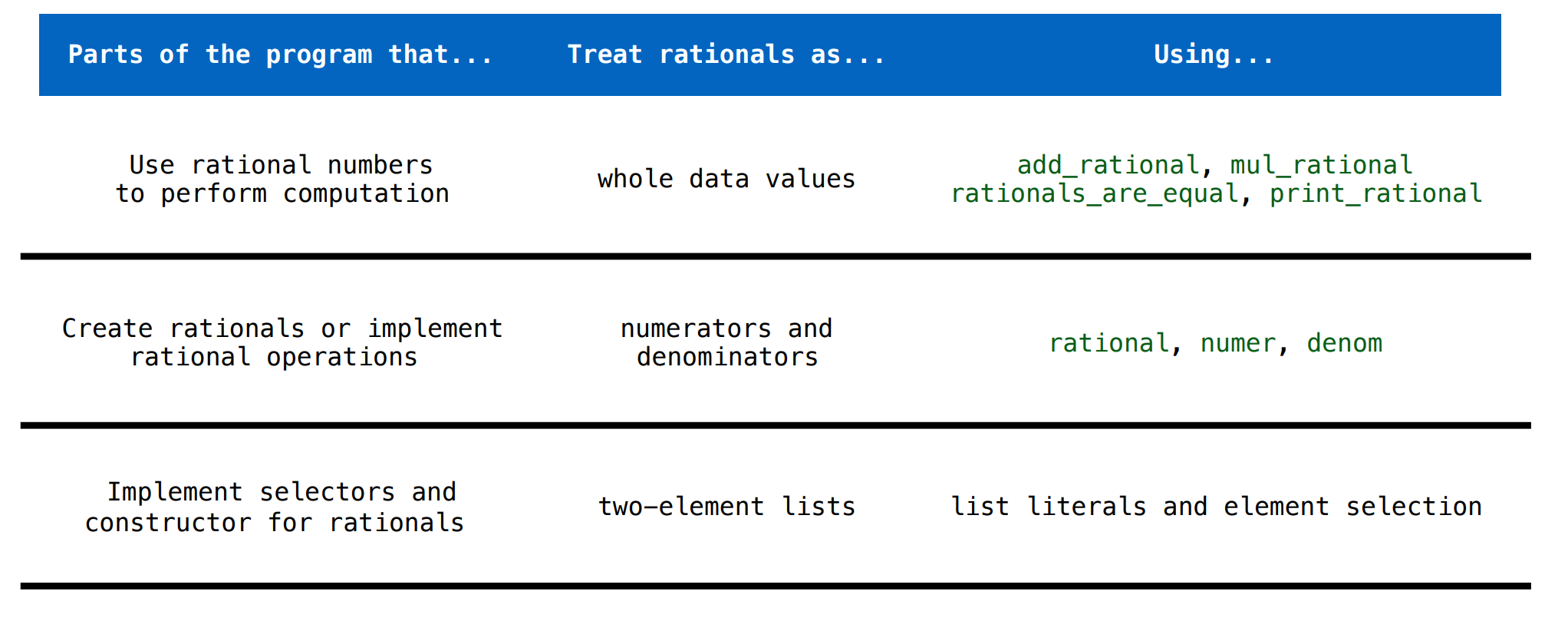
- 对功能进行不同的分层,其层级之间形成abstraction barrier
- 调用部分功能时不要使用过低层级,eg:add_rational( ) 中,使用 rational 、numer、denom函数作为component构建相关函数
- 其目的是为了尽可能减少修改代码时的工作量,即所谓 isolution
Dictionary¶
:::info Basic operation :::
**创建方法**
**dict**(_**kwargs_)****
**dict**(mapping,_**kwargs_)
**dict**(iterable,_**kwargs_)
键值对 {a:1,b:2}
推导式 {x: x ** 2 for x in range(10)}
类型构造器 dict([(a,1),(b,2)])
**methods****字典视图对象**动态变化,不是 iterator 但可以通过函数产生iter(dictview)
**keys()**
**items()**
**values()**
**popitem**()
**pop()**
迭代方法:
- 利用
dic.items产生一个键值对的 listfor i,j in dic.items()2.
key -> value
dic = {'I':1,'A':2,5:a} # 此处的a为已赋值的变量,或者'a'代表变量
>>> dic['I'] == 1
>>> dic.values()
>>> dic.key()
>>> items = dic.items()
>>> dict(items)
>>> dic.get('X',0) # get 打印value ornot print 0
:::info Dictionary comprehension and limitation :::
>>> {x:x*x for x in range(10}
· key 不能重复
· key 不能是可变化的值/list/sequence
· Mutable Data¶
- Mutable Data 用于表示动态变化的值
- py内置的numbers、string、tuple不能变化,sequence可以
- default argument value is part of a function value
def f(s = []):
s.append(5)
return len(s)
>>> f()
1
>>> f()
2
Object¶
- Objects are both information and processes (bundling information and behavior together)
- Objects have attributes,we use dot to represent
- method 相当于function-valued attribute
- In python, all values are objects
Sequence Object¶
# operation on data
# share and identity
''' = 并没有创建新的object 故而 suits 与 chinese 指向相同的object'''
chinese = ['coin', 'string', 'myriad'] # A list literal
suits = chinese # Two names refer to the same list
## 移除
suits.pop() # Remove and return the final element
suits.remove('string') # Remove the first element that equals the argument
## 增添
suits.append('cup') # Add an element to the end
suits.extend(['sword', 'club']) # Add all elements of a sequence to the end
## 更改 mutable
suits[2] = 'spade' # Replace an element
suits[0:2] = ['heart', 'diamond'] # Replace a slice
### slicing 切片时不是mutable的
a = suits[0:2]
## 复制
'使用constructor:list创建一个副本即一个新变量'
nested = list(suits)
nested[0] = suits # 指向suits列表
## check
'identity is much stronger than equality'
'使用 is 或者 is not 判断指向的是否为同一对象'
>>> suits is nested[0]
True
# comprehension
'创建新的list'
## slicing
suits[1:]
## complicated examples
'引用自身的list'
>>> t = [1,2,3]
>>> t[1:3] = [t]
[1,[...]]
'这里的[...]就是这个 list 本身 '
>>>t.extend(t)
[1,[...],1,[...]]
>>> t[1]
[1,[...],1,[...]]
>>> t = [1,2],[3,4](1,2],[3,4.md){#b62caabac6f0b056c943105b6c99d2aa}
>>> t[0].append(t[1:2]) # t[1:2] -> [3,4](3,4.md){#3217f0200a9316574561e220f77a82c2}
[1,2,[[3,4]],[3,4](1,2,[[3,4]],[3,4.md){#cfc817a5247d573d544970abfc9d61ff}
需要注意一点:以 list 作为元素时,是以占位符形式展现的
a = [0,1,2,3,4,[5,6]]
b = a
c = b[:]
print(c is b)
print(c[5] is b[5])
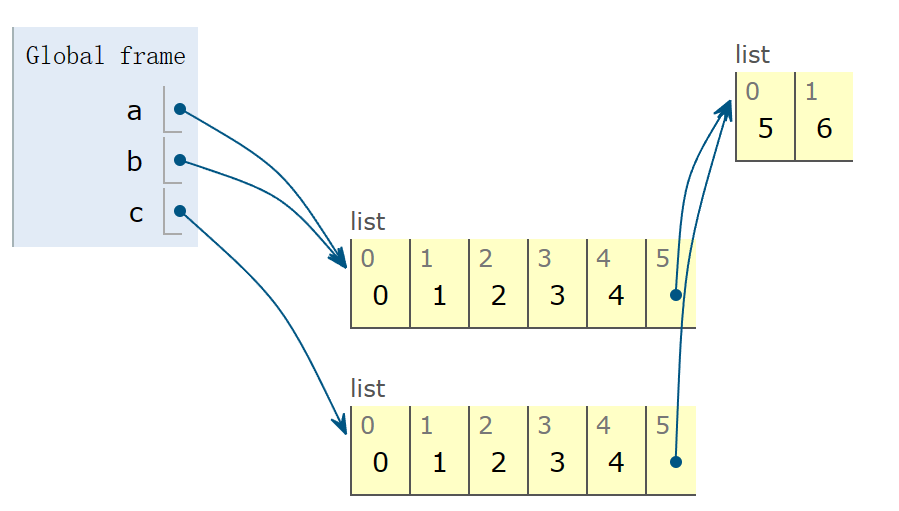
Tuples¶
- 元组 具有类似list的操作,但是元组本身不可以直接改变(unmutable)
- 可以包括任何类型的对象
- 可以对对象进行改变(mutable data)
- 创建,使用 , ( )
>>> 1, 2 + 3
(1, 5)
>>> ("the", 1, ("and", "only"))
('the', 1, ('and', 'only'))
>>> type( (10, 20) )
<class 'tuple'>
>>> () # 0 elements
()
>>> (10,) # 1 element
(10,)
Dictionary Object¶
Dictionaries do have some restrictions:
- A key of a dictionary cannot be or contain a mutable value.
- There can be at most one value for a given key.
#
##
'普通的改变或者增加可以通过赋值语句实现'
## methods:keys, values, and items all return iterable values.
>>> sum(dic.values())
'通过键值对创建dict'
>>> dict([(3, 9), (4, 16), (5, 25)])
{3: 9, 4: 16, 5: 25}
## methods
'get: 如果没有该键值对,返回 0 '
>>> numerals.get('V', 0)
5
String¶
- Unicode,ASCII,UTF-8的区别-腾讯云开发者社区-腾讯云 :::info ASCII : 一个字节 英文编码 Unicode :两个字节 所有编码统一 UTF - 8 :自动决定字节数
TIP :
- 内存统一使用 unicode 编码 :::
Local State¶
- nonlocal statement 必须使用在已经赋值后的变量前[ in nonlocal frame ]
no binging for nonlocal '' found
- 一个变量不能先访问
non-local frame之后再在local frame中赋值
name '' is parameter and nonlocal
- 绑定的是第一个
non-local frame中的name 【enclosing scope】 - 【referential transparency】expression -> 用表达式的值替换表达式之后不影响整个 program
【violate ...】mutable operation
- Instances:
def make_withdraw(balance):
def withdraw(amount):
nonlocal balance
if amount > balance:
return 'Insufficient funds'
balance = balance - amount
return balance
return withdraw
Implementing on List¶
This part is going to introduce one way to creat mutable data structure by mutable function
- Dispatch Function : the message determines the behavior of the function¶
· Object-Oriented Programming¶
· Implementing Classes and Objects¶
· Object Abstraction¶
Objects And Classes¶
instance attribute/fileds/instance variables/propertiesmethods: functions that operate on the object or perform object-specific computations are called methodsattribute/class variables/static variables:difined without the range of methods. It is shared by all the class and among all instances definedinstance attributespecific attributes for one instance**区分**对于 instance ,object访问对象时优先访问instance attr,未寻找到才访问class attribute也就是说,可以存在一个attr只存在于某个特定实例而不存在于class
Creating a class¶
class Account:
# definitiate a new method
def __init__(self, account_holder):
# self is bound to the newly defined class
self.balance = 0
self.holder = account_holder
def deposit(self, amount):
self.balance = self.balance + amount
return self.balance
def withdraw(self, amount):
if amount > self.balance:
return 'Insufficient funds'
self.balance = self.balance - amount
return self.balance
a = Account('Kirk')
# 两种不同调用 function 和 method 的方法
'根据class 和 instance 的不同,返回值也不同'
>>> Account.deposit(spock_account, 1001) # The deposit function takes 2 arguments
1011
>>> spock_account.deposit(1000) # The deposit method takes 1 argument
2011
getattr(instance,attr)
'Return the value of calling it which is identical to the dot expression'
# the attr must be a string
getattr(a,'balance')
hasattr(instance,attr)
'''return True or False'''
- As an attribute of a class, a method is just a function, but as an attribute of an instance, it is a bound method. 区别:当
method被调用时,self 将自动绑定这个object - Python's convention: dictates that if an attribute name starts with an underscore, it should only be accessed within methods of the class itself, rather than by users of the class.
Inheritance¶
is-a类继承has-a聚合- 从父类继承所有attr,但是可以override
>>> class CheckingAccount(Account):
"""A bank account that charges for withdrawals."""
withdraw_charge = 1
interest = 0.01
def withdraw(self, amount):
return Account.withdraw(self, amount + self.withdraw_charge)
Multiple Inheritance¶
- For non-ambigious case, it works nuturally.
- For ambigious case, for example, both the two have one same name, then the order matters
class SavingsAccount(Account):
deposit_charge = 2
def deposit(self, amount):
return Account.deposit(self, amount - self.deposit_charge)
class AsSeenOnTVAccount(CheckingAccount, SavingsAccount):
def __init__(self, account_holder):
self.holder = account_holder
self.balance = 1 # A free dollar!
# one way to find out the order of inheritance
>>> [c.__name__ for c in AsSeenOnTVAccount.mro()]
['AsSeenOnTVAccount', 'CheckingAccount', 'SavingsAccount', 'Account', 'object']
· Efficiency¶
· Recursive Objects¶
Chapter 4 : Data Processing¶
Implicit Sequence¶
Iterator¶
- components
- a mechanism for retrieving the next element in the sequence being processed and
- a mechanism for signaling that the endof the sequence has been reached no further elements remain
- Calling
**iter**on an iterator will return that iterator, not a copy
>>> next(iterator)
7
>>> next(iterator)
Traceback (most recent call last):
File "<stdin>", line 1, in <module>
StopIteration
>>> try:
next(iterator)
except StopIteration:
print('No more values')
No more values
Build-in Iterator¶
- Taking an iterator and return an iterator
lazy processing调用iterator function 不会直接计算结果,返回一个iterator,只有当使用某个数值时才会发生计算. 如:下例中,若之后再次调用doubled相关,将会出错,因为这个iterator已经到达尽头
>>> def double_and_print(x):
print('***', x, '=>', 2*x, '***')
return 2*x
>>> s = range(3, 7)
>>> doubled = map(double_and_print, s) # double_and_print not yet called
>>> next(doubled) # double_and_print called once
*** 3 => 6 ***
6
>>> next(doubled) # double_and_print called again
*** 4 => 8 ***
8
>>> list(doubled) # double_and_print called twice more
*** 5 => 10 ***
*** 6 => 12 ***
[10, 12]
zip
map
reversed
Iterables¶
- Any value that can produce iterators is called an
_**iterable**_** value**. - 对于一些本身无序的结构,如字典和集合,Python 将会内置一个顺序,使得
iter``next可以正常运行 - 但如果改动或删除了
key,将会出现新顺序,之前产生的iter失效 - 在高版本py中字典已经有了顺序
Generator¶
- is one type of special iterator
- returned by a special class of function called a generator function.
- 每次调用直到到达
yield时return一个generator,并记录此次运行的 name 和 value,下一次从此次结束处重复操作
>>> def letters_generator():
current = 'a'
while current <= 'd':
yield current
current = chr(ord(current)+1)
>>> for letter in letters_generator():
print(letter)
a
b
c
d
- 产生可重复使用的 iterable (Creating Iterables with Yield)
class LettersWithYield:
def __init__(self, start='a', end='e'):
self.start = start
self.end = end
def __iter__(self):
next_letter = self.start
while next_letter < self.end:
yield next_letter
next_letter = chr(ord(next_letter)+1)
class LetterIter:
"""An iterator over letters of the alphabet in ASCII order."""
def __init__(self, start='a', end='e'):
self.next_letter = start
self.end = end
def __next__(self):
if self.next_letter == self.end:
raise StopIteration
letter = self.next_letter
self.next_letter = chr(ord(letter)+1)
return letter
Library¶
Standard Library¶
Q & A¶
浮点数问题¶
- 保留位数
使用 round 函数 四舍五入类型的函数 如果有 0 存在自动舍去多余的0
>>> round( 4.000 , 2 )
4.0
>>> round(4,2)
4
>>> round(float(4),2)
4.0
-
其他常用函数的细节¶
- max & min
# 原型
max(iterable, *, default, key=None)
''' 返回第一个找到的max值
iterable为空时返回default
key为指定的 实际传入list.sort()的参数
'''
# 应用
'''按字典顺序比较'''
## 比较字符串
>>> max('1', '9', '10', '100') # 返回多个字符串中最大的字符串
'9'
>>> max('asdxyz')
'z'
## 比较列表
>>> min(['8',4],['8',4,'2']) # 返回多个列表中最小的列表
['8', 4]
>>> min(('8',4, '3'),('8',4,'2')) # 返回多个元组中最小的元组
('8', 4, '2')
## 比较字典 注意 返回值为 键
>>> d = {'x':5, 'y':7, 'z':3}
>>> min(d) # 返回字典元素中的最小值,结果是最小的键
'x'
>>> min(d , key = lambda x:d[x])
'z'
- print函数
一些思考方式¶
- 分cases考虑递归问题 tree的想法